The Pass Labs INT-250 is based on their acclaimed .8 series amplifiers. This integrated is essentially a Pass X-250.8 stereo amplifier with a custom preamp added in. That preamp is relatively simple in its feature set, but still delivers every bit of the sound quality one would expect from Pass Labs. The amp is beautifully built down to every last detail, incredibly massive and solid, and offers sound quality most audiophiles can only dream of.
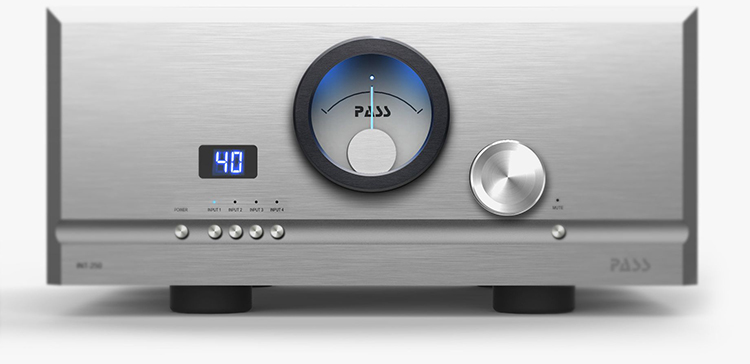
Pass Labs INT-250 Integrated Amplifier
- 250W per channel into 8 ohms and 500 into 4 ohms for real. No cheating.
- Sold as a class AB amplifier, but biased well into class A. Leaves class A at 15W.
- This amp is built like a tank. It weighs 105 lbs. And that’s not just a big case with a bunch of empty space inside.
- Beautiful build quality. The best I’ve ever seen.
- Simple preamplifier with all the features you need for a music only system.
- At $12,500, it’s very expensive. But you get what you pay for.
You have to possess quite a bit of self-confidence to buy a high end integrated amplifier. Audiophiles love to change their mind and they love to have buyer’s remorse. Nothing ever seems to be good enough, and the promise of that next upgrade that will lead to nirvana is always nagging. Until one day, you decide you’ve had enough. You finally decide you want to buy one set of gear, preferably simple and of superb quality, and just stop worrying. If this sounds like you, then Pass Labs has designed and built the INT-250 just for you. Most integrated amps are some sort of compromise. The INT-250 is not. It’s one of the most overbuilt, over-engineered integrated amplifiers there is. I guarantee that if your goal is to build a simple, 2 channel audio system that offers world class sound so you can just stop worrying and enjoy listening, the INT-250 is pretty hard to beat. It is the best sounding preamp/amplifier I’ve had in my listening room thus far.
Power:
250Wpc into 8 Ohms
500Wpc into 4 Ohms
Gain:
30db/36dB (balanced/single ended)
Volume Control:
63 dB in 1 dB steps
Inputs:
4 (single ended and balanced for each)
Preamp Outputs:
2 (single ended and balanced for each)
Frequency Response:
-6dB at 80 kHz
Distortion:
1% at 1 kHz at full power
Input impedance:
45 kOhm per leg
Damping Factor:
150
Output noise:
<250 uV
Input CMRR:
<-60 dB
DC Offset:
<50 mV
Leaves Class A:
15W
Power Consumption:
450W
Size:
19”x21.25”x9.1”
Weight:
105 lbs.
MSRP:
$12,500
Company:
SECRETS Tags:
Integrated Amplifier, Integrated Amplifier Reviews – 2017
You don’t even need to unpack the box to know the INT-250 is a very serious piece of audio gear. The crate weighs 125 lbs. I managed to wrestle it into the house and get the amp out of the box by myself, but I do not recommend this. Of course, if you drop over twelve thousand clams on an amplifier, I expect the dealer will deliver it and put it into your rack for you. Luckily, the amp has two big handles on the back, and big, sturdy rubber feet that will help you heave it into place. The big INT-250 barely fit into my rack, with only a couple of mm to spare on each side of the big, sharp heat sinks. Once in place the amp looks the part.
It has the signature Pass current meter bathed in blue LED light in the center of the front panel, with a big, nicely weighted volume knob driving a digital potentiometer with 63 dB of range adjusted in 1 dB steps. There’s a power switch and 4 selectors for the 4 line level inputs, and a blue LED display for the volume setting. This is all set into a beautifully machined aluminum faceplate. If any amp looks like it’s worth the price, this is one. The rear panel contains both single ended and balanced inputs for two of the four inputs, with single ended only for the other two. The INT-250 is fully balanced all the way through, so you really get all the benefit from the balanced inputs.
The single ended inputs are cloned and inverted, and then sent through the amp balanced. The speaker level outputs are differential, so do not ground either of them! Both single ended and balanced preamp outputs are provided to drive a subwoofer amp or a second amp for bi-amping. There’s a ground lug and a IEC power socket with a power switch. Finally, Pass’ very nice binding posts with tightening clutches on the easy to grab wingnuts are present.
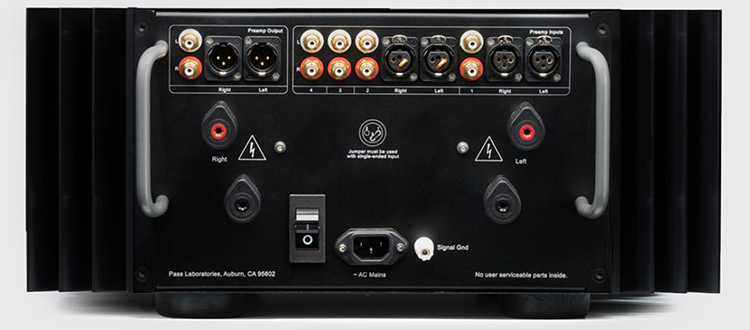
When powering up, the amp starts with the preamp volume at zero and the inputs muted. The amp automatically unmutes after a couple of seconds. There is no provision for a home theater passthrough, which for me was a bit annoying. I used input 1 for this purpose, with the volume set to maximum. While the amp remembers the last input, the fact that it starts at zero dB on the volume every time for safety means I had to ramp up the volume manually each time. I guess I could have left the amp on all the time, but that leads to another issue.
This amp gets HOT. It’s biased to leave class A operation at 15W output. In fact, many manufacturers would probably call this a class A amp, not class AB as Pass Labs does. The result of this biasing is fantastic class A sound that reminded me of the XA-30.8. The downside is that it works like a 450W space heater. If you live somewhere cool, that won’t be a problem. But I live in Arizona. When I got the amp in the fall (it can still get close to 100F outside in Phoenix in October), it wasn’t so great. A very nice machined aluminum remote is included, but some buttons on it do not work. The remote is a standard Pass Labs product, not specific to the INT-250. The power, volume, mute and source selector buttons work, but there is no provision for balance control or home theater passthrough.
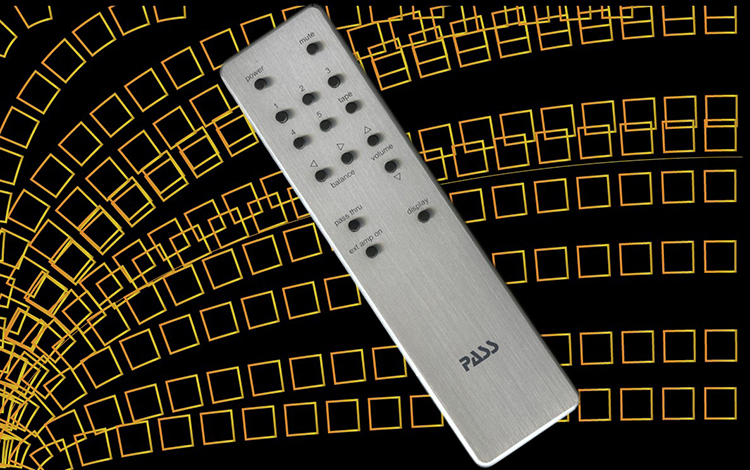

Sometimes, people say to themselves that this is just a result of the source material. Many modern, highly produced albums can sound a bit 2D. But not all. One of my standard litmus tests is Daft Punk’s Random Access Memories, in 24 bit 88.2 kHz.
This album has an amazingly large, 3D soundstage and images with the right equipment. The INT-250 did not disappoint. A great test of subtle timbre is the track Giorgio by Moroder. This track is recorded with a selection of vintage microphones spanning the career of Giorgio Moroder, one of the pioneers of electronic music. Only the best systems can clearly reveal the tonal differences between these microphones. Usually, it’s easiest to hear with headphones. But the INT-250 did a fantastic job here. With my normal Rogue preamp and NewClear amp, the tonal differences are there and audible, but with the INT-250 they’re even more clear. That’s always the sign of a good piece of equipment. You get to hear things in familiar recordings you have never heard before.

One of the things the INT-250 has that the XA-30.8 didn’t was fantastic bass performance. One small drawback of the “little” XA-30.8 was a bit of a limitation in bass impact and power. No such problem with the INT-250. I put on my favorite bass torture track, High Roller from Crystal Method’s debut album Vegas.
In writing this article, I was alarmed to read this album came out in 1997. I guess I’m getting old. This track has some serious, low, powerful bass. At high volume levels you can see standing waves in surfaces of drinks in the listening room. Stuff vibrates. The INT-250 was able to reproduce High Roller without giving up one bit of power, extension or slam.

The INT-250 was also able to deliver amazing subtlety with more delicate music. One of my favorite singer-songwriters is Emiliana Torrini. Another litmus test is the first two tracks on her album Fisherman’s Woman.
The tracks Nothing Brings Me Down and Sunny Road are about as simple as it gets. A female voice and an acoustic guitar. No drums, no other instruments, and little to no “production.” With the right system, Torrini’s voice is genuinely haunting. The INT-250 delivered the most realistic reproduction of this singer’s voice in my listening room I have heard to date.
The image had something that is typically not easy to reproduce: a realistically large image, located in space in a plausible way. Most systems give you a “scale model” of reality, almost always smaller than reality. Not here. It’s about as good as it gets. The other test is the detail and timbre presented. If it’s good, you get chills when the music starts because it really tricks you into thinking that it could be live music, if only for a few seconds.
Measurements were made with my M-Audio ProFire 610 firewire audio interface and Spectra Plus FFT software. I drove the INT-250 with a 24 bit, 192 kHz bandwith test signal from the analog outputs of the ProFire 610. The signal was 0 dBFS. I adjusted the preamp setting of the INT-250 to give the maximum RMS voltage level at the 8 ohm test resistor that I could deal with. This is 5V rms or a bit over 3W. This level signal is the maximum I can feed into the ProFire 610 as-is without overloading the input. It turns out this test is not so unrealistic.
The volume setting on the preamp was significantly louder than when I normally listen to music (44 out of 63 on the digital volume control of the INT-250). I have a voltage divider box I built to allow higher power levels, but this setup does not work with a balanced amplifier where you can’t ground the negative amp terminal. I’ll have to build another one for balanced amps, but I didn’t have time for this test. So instead, I grounded the negative terminal of the ProFire 610 to the ground lug on the INT-250 case and measured the positive leg of the INT-250. Since this test method negates some of the advantages of the all-balanced INT-250 the measurements should be considered worst-case.
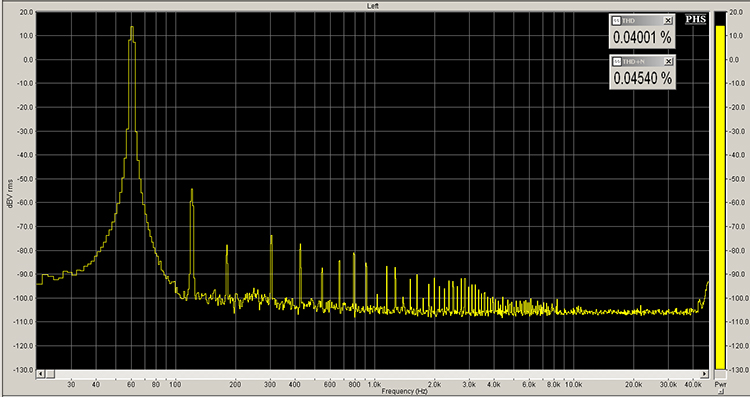
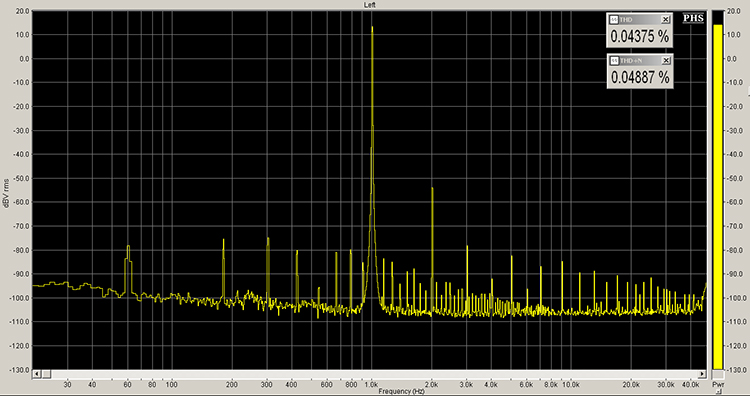
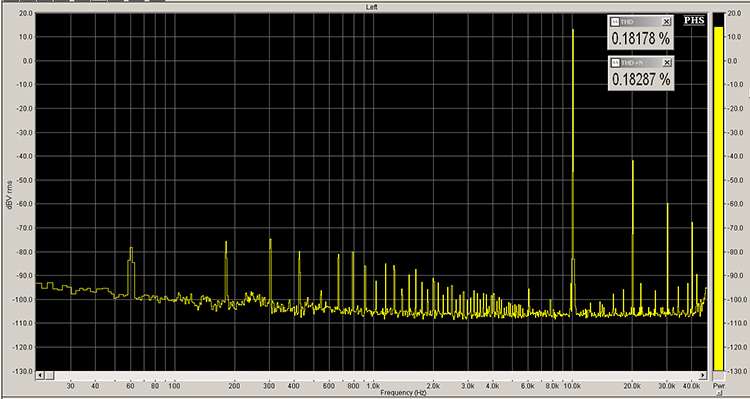
Distortion spectrum results are excellent, with very low absolute levels of harmonic distortion, with the exception of the 10 kHz measurement. The 0.18% there is more typical from a power amplifier. Even more important is something overlooked by most. The 2nd harmonic is 20 dB higher than the 3rd harmonic, which is again close to 10 dB more than higher harmonics. This is a super important result. Distortion concentrated in the 2nd and 3rd harmonics is what you want to see. Distortion in these harmonics tends to sound good to the human ear. Higher orders do not sound good.
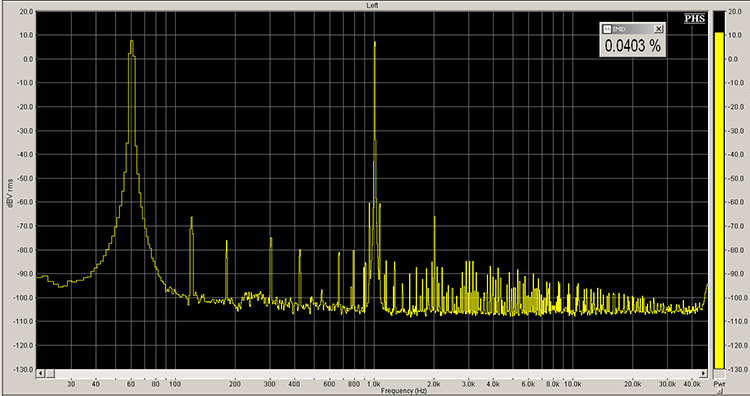
The intermodulation distortion results are also very good, with mixing products about 70 dB down from the fundamental and total IMD measured at 0.04%. This is again an excellent result for an amplifier.
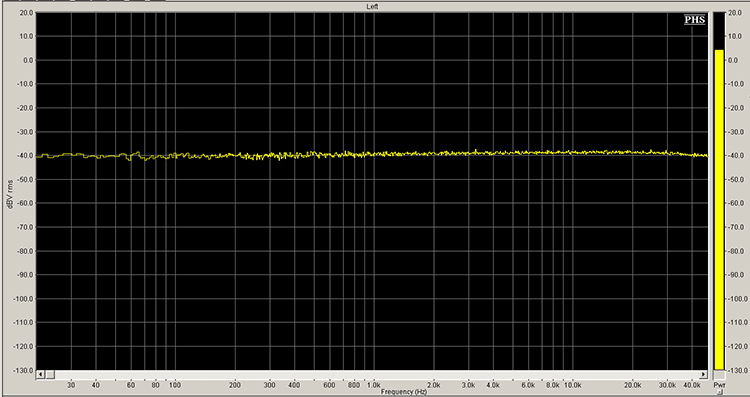
Frequency response is flat as a pancake to the limit of the sound interface. The gentle rise towards 48 kHz is an artifact of the measurement.
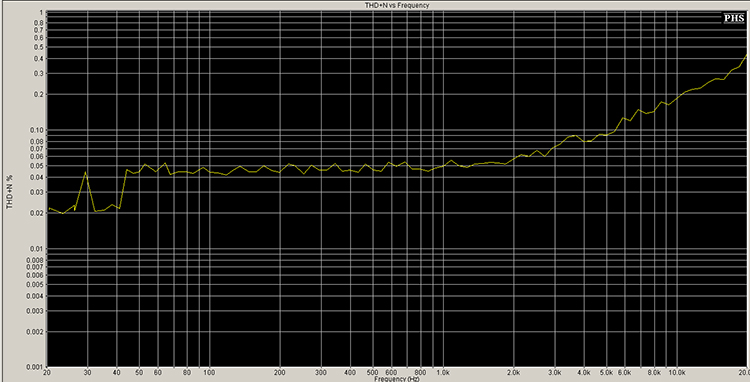
The THD+N measurement shows excellent performance as well. I’m not sure what’s causing the rise in THD+N at high frequencies. The absolute numbers are still low, but both the 10 kHz spectrum and the THD+N plot does show an increase at high frequencies.
THE PASS LABS INT-250 is expensive, without a doubt. But it is also the best integrated amp I’ve ever heard. Actually it’s the best amp and preamp I’ve ever heard in my own listening room. In my opinion, it’s worth the money as long as it gets used in the way it was designed: as the core of a world class music-only soundsystem.
- World class sound quality. It’s probably the best sounding amp of its type in existence.
- Excellent build quality and styling.
- Simple and upgrade proof. You’ll likely never need to upgrade it as long as you use it for what it was designed.
- It looks, feels and sounds like it’s worth the money.
- Measurements are almost flawless.
- This amp gets really hot. Probably fine for most, but I live in Phoenix, AZ. It gets the listening room a little warm.
- A home theater pass-through feature so the amp can be more easily integrated into a more complicated system.
The Pass Labs INT-250 is a fantastic amplifier. If you want to build a world class music only system, it’s hard to argue that you need anything more than this amplifier. For my more complicated system that does double duty as a home theater system, two small drawbacks of the INT-250 matter: the lack of a home theater passthrough, and the very high power dissipation that heats up the listening room. But I don’t actually knock the INT-250 because of these. The INT-250 was not designed to be part of a complicated system. It was designed to be the heart of a simple one. If I had the means to 1) have a dedicated music only system and 2) afford the INT-250, I would very seriously consider it. If you tried to build something from separates, I don’t think you could do it for the $12,500 cost of the Pass amp and equal or beat the sound quality you get with the INT-250. In that sense, the INT-250 is actually a great value. I strongly recommend you listen to this amp if you get a chance. I doubt you’ll be disappointed.



